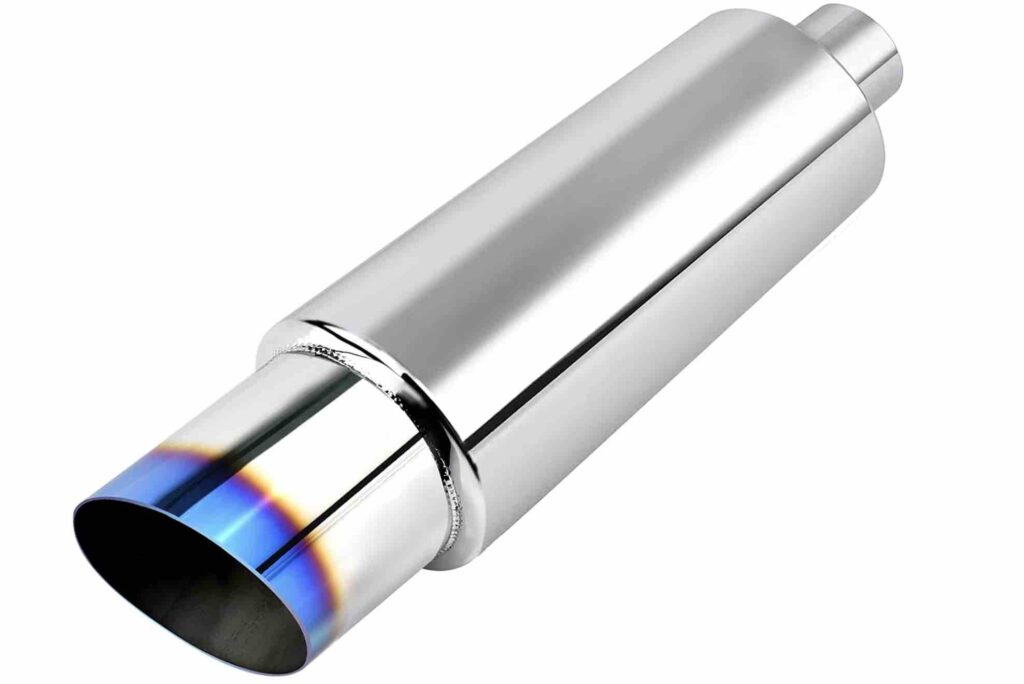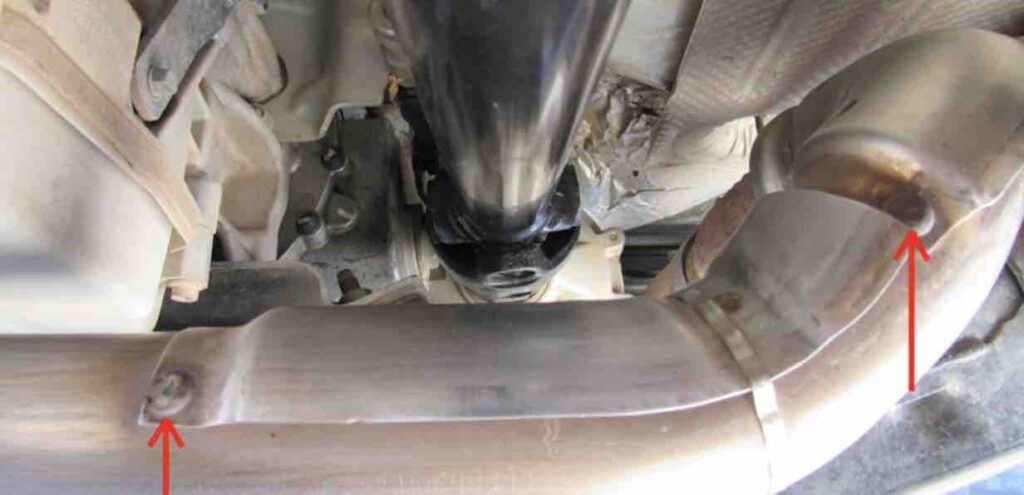Last updated on February 20th, 2023 at 10:35 am
Catalytic converter vs muffler, what are the differences? If you are reading this, I am sure you have thought about the distinction or difference between a muffler and a catalytic converter within your car.

While both components are essential for your vehicle’s exhaust system, they both function differently.
So let us look at each one of them further, and in this article, I will discuss and show a comparison table of catalytic converters vs mufflers while addressing the following question: how much does it cost to replace a muffler catalytic converter? Can a muffler replace a catalytic converter? and lastly we talk about hte distance between catalytic converter and muffler in a car.
Difference between muffler and catalytic converter
What is a Muffler
We can describe a muffler as a sound-dampening device located at the exhaust manifold where the car exhaust gasses are extracted from and passed through the catalytic converter.
Due to the fact that a car’s ICEs (internal combustion engines) are very powerful, which makes it produces a lot of noise when they are in use. The mufflers are present to help resolve the noise pollution.
So the primary function of the muffler is to keep your car quieter or to reduce noise coming out from your car.
Without the muffler, your engine would create an unmuffled roar that could be deafening for those driving every day. While loud exhaust sounds might sound awesome on muscle cars, everyday drivers like us would find them annoying.

How a Muffler Reduces Sound
When your engine runs, controlled explosions occur inside its combustion chambers. This creates noise that travels down through your car’s exhaust system and eventually ends up at the muffler.
The muffler then channels the air, sound, and gases through a maze of perforated tubes and chambers where sound energy is converted into heat energy.
Mufflers come with various designs, functions, and noise cancellation levels that can produce different results for your vehicle; some aim for quiet operation, while others create “mean” sounds. When selecting the right one for your car, be sure to inform the technician what sound signature you’re going for!
Another function of a muffler is to direct any remaining hazardous gases away from your car’s cabin. Without this protection, these fumes could seep into the cabin and cause harm to both you and other passengers.

Can a muffler replace a catalytic converter?
The answer is “no” because a muffler and catalytic converter serve two different purposes in an exhaust system. Mufflers are designed to reduce engine noise through destructive interference of sound waves, while catalytic converters, on the other hand, help to transform harmful gases into harmless ones through chemical reactions. They differ in construction; fin instance, the mufflers feature perforated pipes and baffles, while the Catalytic converters consist of a honeycomb structure coated with metals.
What Catalytic Converter is.
The primary function of a catalytic converter is to reduce harmful exhaust gases produced by your engine. Without one, all those harmful fumes would escape back into the atmosphere – contributing to air pollution and all its related issues.
How a Catalytic Converter Reduces Exhaust Gases
Once your engine is started, small explosions in its combustion chambers fire in sequence to propel you forward. Unfortunately, these explosions create chemical reactions that produce gases hazardous to us and the environment.
Catalytic converters can reduce these gases by transforming them into less hazardous forms like oxygen and water vapor.
What occurs inside of a catalytic converter to reduce exhaust gases?
The catalytic converter begins with an intake where exhaust gases enter. A metal shell, consisting of two parts, houses the inner components while serving as a heat shield to dissipate heat. A ceramic honeycomb is then created – this mass of porous ceramic allows air to freely pass through it and maximize surface area for reactions to take place. Metal catalysts such as noble metals are then utilized to initiate chemical reactions that transform harmful gases into harmless ones.
The catalytic converter is essential to your vehicle’s exhaust system, helping reduce harmful emissions and enhance air quality. If damaged or malfunctioning, it can adversely affect performance and contribute to pollution.
Signs that your catalytic converter may be damaged or malfunctioning include decreased fuel economy, diminished engine performance, and the illumination of the check engine light. If you observe any of these symptoms, it is essential to have your vehicle inspected by a qualified mechanic immediately.
In addition to helping reduce harmful emissions, the catalytic converter plays an integral role in maintaining your vehicle’s overall performance. A damaged or malfunctioning catalytic converter can cause your engine to run poorly, leading to decreased fuel efficiency and diminished power output.
To keep your vehicle running optimally and improve air quality, it is essential that the catalytic converter in your car is in top condition and functioning optimally.

So what is the Difference Between Muffler and Catalytic Converter
See the breakdown in the comparison table below of how to tell the difference between a muffler and a catalytic converter.
Difference Between catalytic converter and muffler
| S/N | Point | Muffler | Catalytic converters |
|---|---|---|---|
| 1 | Function | The main function or purpose of the muffler is to reduce the car engine’s noise. | While a catalytic converter’s function is to convert harmful gases into harmless ones, thereby reducing emissions. (eg. H20, N2, CO2) |
| 2 | Principle | Mufflers use destructive interference to cancel out sound waves. | Catalytic converters use reduction and oxidation reactions to convert harmful gases into less harmful ones. |
| 3 | Type of process | The noise cancellation process for Mufflers is based on a physical process. | We can say that the conversion process with Catalytic converters involves a chemical process. |
| 4 | Construction | Mufflers are made up of perforated pipes and baffles. | Cat converters comprise of a honeycomb structure coated with platinum, rhodium, palladium, and sometimes beads. |
| 5 | Working | Exhaust gases are passed through perforated tubes and baffles in mufflers to reduce noise. | In catalytic converters, exhaust gases are passed through small pores of a honeycomb structure to convert harmful gases into harmless gases. |
| 6 | Material | Mufflers are generally made of aluminized steel, cast iron, etc. | While catalytic converters use precious metals like rhodium, platinum, and palladium to perform it task |
| 7 | Location | Mufflers are located at the end of the exhaust system. | Catalytic converters are located between the engine and the muffler. |
| 8 | Cost | Mufflers are less expensive than catalytic converters. | Catalytic converters are more expensive due to the precious metals used. |
| 9 | Life | Mufflers have an average life of 4-5 years. | Catalytic converters work effectively for 10-20 years. |
| 10 | Signs of failure | Mufflers exhibit loud noise and lowering of fuel economy when they fail. | Catalytic converters exhibit rattling noise, and engine misfires when they fail. |
| 11 | Cause of failure | Mufflers corrode due to moisture. | Catalytic converters fail due to overheating, choking, contamination, etc. |
How much does it cost to replace a muffler vs a catalytic converter?
Well, the cost to replace a muffler or a catalytic converter depends on the make and model of your vehicle, the location, and the price of the mechanic you hire.
On average, replacing a muffler can cost from $100 to $850 for labor and $75 to $300 for parts. On the other hand, replacing a catalytic converter can cost anywhere from $500 to $2,500 or more, including labor costs and the cat.
How much is muffler repair
The average cost of muffler repair can be the most costly of all repairs. It is estimated that you will pay between $100 and $850 if your vehicle is taken to a professional repair shop. This price is just for labor; it does not include any taxes or fees.
what is the distance between catalytic converter and muffler
The distance between a catalytic converter and muffler is different for various vehicles, which mostly depends on the make and model of the car and the specific exhaust system configuration. However, in most vehicles, the catalytic converter is usually close to the engine towards the front, whereas the muffler is located at the back. The distance between them can range anywhere from a few feet up to several yards, of course, this will depend on how long your exhaust system and vehicle layout are.
There are also some instances, the catalytic converter and muffler may be combined into a single unit, known as a “cat-back” exhaust system. There is no distance between the two components in such instances since they are physically attached together.
Conclusion
In summary, while both the catalytic converter and muffler are essential components of your vehicle’s exhaust system, they perform very different functions. The muffler is designed to reduce your engine’s noise, while the catalytic converter helps reduce harmful emissions.
Suppose you want to keep your vehicle running smoothly and, at the same time, promote a toxic-free environment. In that case, it’s essential to ensure that both your muffler and catalytic converter are in good condition and functioning correctly. Regular maintenance and inspection can help identify any issues early and prevent more significant damage.
Read also: Universal DIY Electric Car Conversion Kit

Uchenna is a Radiographer and Auto parts mechanic who recently got his automotive diploma as an auto repair technician, and since then, has worked on fixing various car problems.
Working as just a radiographer, Uchenna didn’t just get all the fulfillment he desired, because he truly loved doing things tilted toward cars. As a kid, he would take apart his toy cars to see how they worked and would spend hours tinkering with his bike.
So, in 2017 he made the tough decision to become an auto mechanic. He threw himself into his studies and now loves every aspect of what he does.
He gets to work with his hands, solving problems and bringing cars back to life, and sharing his knowledge and easy quick-fix guide online are all part of what makes him feel fulfilled.


